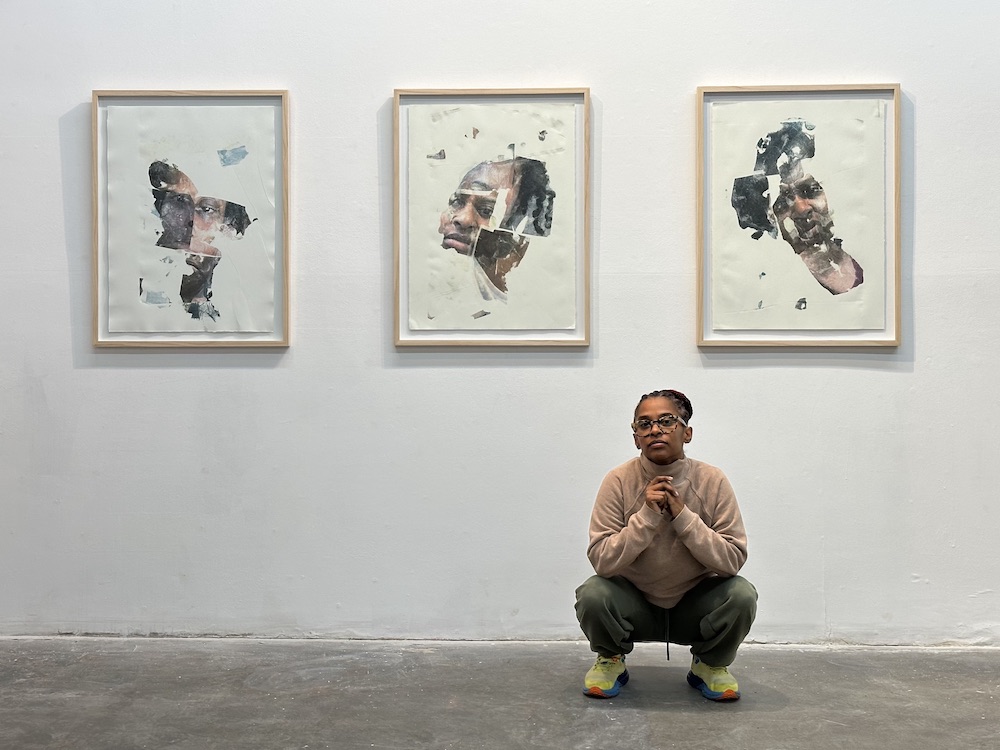T.J. Dedeaux-Norris had already segued from performance and music to painting and printmaking before completing her MFA at Yale, but she foregrounds the performative aspect of her approach in “Breach of Confidentiality,” her debut solo exhibition at Walter Maciel Gallery. Dedeaux-Norris developed the exhibited works around a kind of personal story, or as she might have it, a “narrative.” Upon entering the gallery, our first glimpses of that tale are willfully fractured; we see cut and collaged fragmented images, transformed into unique acetone transfer prints. These “reclaimed” images (as the exhibition text describes them) remap and recompose the artist’s identity over time and space; but the works are not merely about identity. The subject matter is an uncertain terrain, which the artist makes visually and materially manifest.
Throughout the exhibition, Dedeaux-Norris employs a variety of media and compositional strategies to self-reflexively tease out the generative implications of printmaking and explore the notion of what is actually ‘imprinted’. In Plaintiff’s Testimony: Visual Reclamation (United States) #1 (2024), Norris maps, plots, subdivides an image of her own face—the ‘plaintiff’s’ terrain, conceivably one and the same with her ‘testimony’. Eyes are freely sliced and spun off a facial ‘compass’, while a chin floats assertively in the lower quadrant. There’s a grisaille cast to the whole of the composition. Although flesh tones in certain fragments pop, others seem tamped down, almost greige. The fragments seem on the verge of floating to the periphery of the compositional field—a visually diasporic identity.
Two other iterations of Testimonies selectively repeat or reconfigure this bodily and facial ‘mapping’, variably reflecting presumed expressions of complaint (regret, sadness, anger, or consternation) and challenge the viewer’s instinct to construct or reconstruct the image into something easily recognizable. Dedeaux-Norris’s challenge —to our culture’s claim (or ‘imprint’) on personal identity—is expansive. As plaintiff, Dedeaux-Norris asserts a claim to everything she might be or wishes to become. Her Deposition series extends this challenge, positing herself as defendant, while fragmenting the field even more aggressively. Apparent concern or anger trouble eyes and facial fragments, although Deposition of Identity: Art As Witness, U.S. v. Dedeaux-Norris (#3), (2024) foregrounds fingers that might touch such troubled eyes.
Hanging weavings—of found or discarded fabrics woven through with yarns—extend and complicate Dedeaux-Norris’s inquiry into how identity is deposed and imprinted, highlighting the subjects’s inherent fluidity and uncertainty. Pale blue braided yarns or bits of vaguely plush animal-like garland snake through bits of scarves or sweatering, do-rags and discarded underthings in North Hollywood Hearsay (2024), while long, twisted braids or lanyards of fabric and errant threads drip from its lower edge as if seeping away from a dubious field of causality. In Reseda Remains (2024), a long wrinkled length of printed sheeting spirals to the floor beneath, suggesting flight from long ago catastrophe—which may be more than just notional: the artist’s pursuit of a hip-hop career between high school and university exposed her to an environment easily as sexually predatory as it was creative.
The process of ‘imprinting’ is one thing, Dedeaux-Norris seems to say; while what remains—what stands or falls—is quite another. Along a corridor leading to the rear gallery, a series of hanging works further test out this theme. The artist collages onto small (8×8 sq.in.) wood panels hand-cut, variously hand-tinted, or glittered dry-transfer Roman style letters over printed fragments of diary entries and various writings from her childhood, with occasionally superimposed silhouettes or colored pencil drawing and doodling, the whole epoxied over into a kind of glossy souvenir of an impossible-to-memorialize, much less recapture, past. Titled Evidence of Silence (Exhibits A through N (2024)), they are anything but. These works are resonant, almost meditative objects that simultaneously whisper and shout. Some of the letters appear to flake or separate from the surface, underscoring their instability, or simply the distance between plausibility and proof.
The last gallery is given over to a tour de force display of work that is both exuberantly performative and subsumed within what the artist has compressed into a not-merely-decorative backdrop. Against one wall is an almost banner-scale inkjet print of the artist all but spread-eagled in an expansive, wildly balletic leaping pose within a wispy, vaporous aura (Body of Evidence: Latent Print, 2024). Against the other (and filling it floor to ceiling) is what appears to be a block-printed wallpaper that, on closer inspection display repeating matrices of asterisks which are themselves composed of identical miniature prints of the artist in grand jeté leaps—like a six-pointed ‘Spirit (or snowflake) of Ecstasy’. Perched salon-style across the wall are small (9×12 sq.in.) transfer prints of the artist in variously balletic or yogic poses, with gestural watercolor and pencil markings. Also titled Body of Evidence (January through December, 2024), they collectively offered a kind of reification of the aspirational ‘reclamation’ staked out in her Plaintiff’s Testimony—not of identity, per se, but of a fully realized self.


